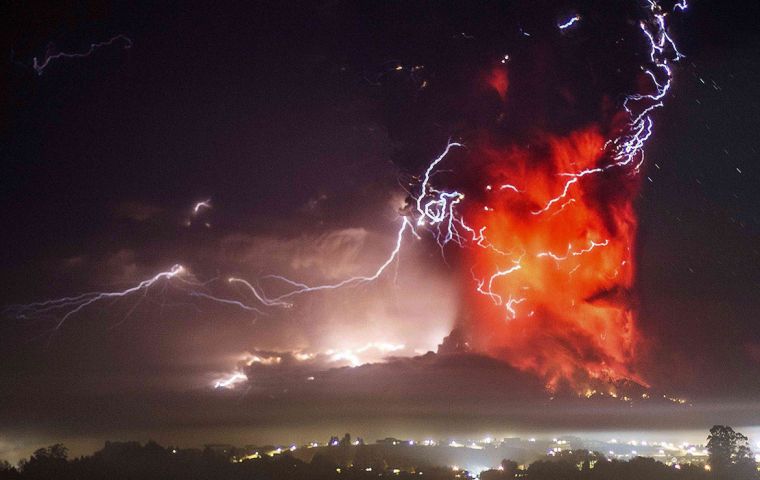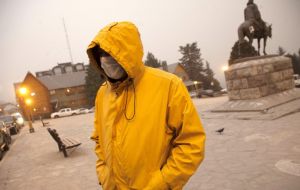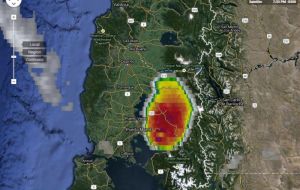MercoPress. South Atlantic News Agency
Chilean volcano third blast forecasted; ashes reach neighboring Argentine provinces
 The 2.200 meters Calbuco last erupted in 1972 and is considered one of the top three most potentially dangerous among Chile's 90 active volcanoes.
The 2.200 meters Calbuco last erupted in 1972 and is considered one of the top three most potentially dangerous among Chile's 90 active volcanoes.  Parts of Argentina reported heavy ash falling after the eruption. The ash cloud was shot as high as 10.000 meters high and the wind is moving the mass.
Parts of Argentina reported heavy ash falling after the eruption. The ash cloud was shot as high as 10.000 meters high and the wind is moving the mass.  “Our problem is a respiratory one, from inhaling all of this ash, and the fact that this ash could generate some sort of environmental contamination” said Bachelet
“Our problem is a respiratory one, from inhaling all of this ash, and the fact that this ash could generate some sort of environmental contamination” said Bachelet  The first eruption could be seen via infrared satellite. The second eruption was also visible on satellite even as the ash plume from the first drifted north and east.
The first eruption could be seen via infrared satellite. The second eruption was also visible on satellite even as the ash plume from the first drifted north and east. Chile's Calbuco volcano erupted for the first time in over 42 years on Wednesday, creating a remarkable scene of smoke plumes and ash shooting into the sky. A second eruption Wednesday night blasted red-hot rocks skyward and produced an extraordinary display of volcanic lightning. Winds are pushing the ashes north and easr to several neighboring Argentine provinces.
The volcano sent ash more than 10 kilometers skyward, increasing concerns that the dust could contaminate water, trigger respiratory illnesses and halt more flights.
The first blast surprised Chilean emergency officials, who were left with only minutes to issue an alert.
Parts of Argentina reported heavy ash falling after the eruption. According to analysis by Argentina's meteorological service, the ash cloud was shot as high as 10.000 meters high.
Meteorologist Chris Dolce of The Weather Channel pointed out that you could see the first eruption via infrared satellite. The second eruption was also visible on satellite even as the ash plume from the first eruption drifted north.
As the ash cloud spread Wednesday, “people went into a state of panic,” said Miguel Silva Diaz, an engineer who lives in Puerto Montt, a city about 20 kilometers from the volcano. “Then, at around 1 a.m., I heard a loud noise, as if somebody had detonated an atomic bomb.”
No injuries were reported and the only person reported missing since the eruption was located Thursday.
Authorities evacuated 4,400 people as gas and ash continued to spew, and they closed access to the area around the volcano, which lies near the cities of Puerto Varas and Puerto Montt, some a thousand kilometers south of Santiago.
“I was shocked. I had just arrived home when I looked through the window and saw the column of smoke rising up. We called our families, posted photos,” said Daniel Palma, a psychologist who lives in Puerto Varas.
“We woke up today with a blanket of fog and it hasn't cleared. We have a layer of smoke above us,” Palma said, adding that many were concerned about the possible effects of the ash on their health.
The Chilean national geology and mining service warned that people should prepare for a third and “even more aggressive eruption.”
President Michelle Bachelet declared a state of emergency, saying the eruption of Calbuco was “more serious and unpredictable” than the one last month at the Villarica volcano, which also forced the evacuation of thousands.
“We don't have any problems with supplies, water or sewage up to now. That's not the problem,” said Bachelet, who visited the area Thursday. “Our problem is a respiratory one, from inhaling all of this ash, and the fact that this ash could generate some sort of environmental contamination.”
The short-term dangers related to the ash also include eye and skin infections as well as water contamination, said Bernardo Martorell, a physician and the head of the sanitary planning division at Chile's health ministry.
“That's why the people in the area need to evacuate,” Martorell said.
Ash continued to fall Thursday in Puerto Montt and other nearby cities, said Patricio Vera, director of a local radio station. Vera said that after the initial eruption, hundreds of people rushed to buy gasoline, forcing stations to ration sales, while supermarkets closed early to avoid the risk of looting.
The 2.200 meters Calbuco last erupted in 1972 and is considered one of the top three most potentially dangerous among Chile's 90 active volcanoes.
LATAM and other airline companies cancelled flights to and from Puerto Montt because airborne ash can severely damage jet engines.
In 2011, a volcano in the Caulle Cordon of southern Chile erupted violently, forcing the cancellation of hundreds of flights and the evacuation of more than 3,500 people. Thick, abrasive soot coated slopes in the ski resort city of San Carlos de Bariloche, over the border in Argentina.
By Thursday afternoon, much ash had made its way to Villa La Angostura, Argentina, a small town about 90 kilometers northeast of Calbuco. Cars and streets were coated with a thin layer of ash, but people were otherwise going about their business.
“We are praying that the volcanic activity will be as short as possible,” said mayor Roberto Cacault.




Top Comments
Disclaimer & comment rules-

-

-

Read all commentsAsh is starting to arrive in BA now. I will be off to buy some air filters for my car before they run out. For those of you who have never experienced it, the ash everywhere is terrible. We have only just got over the affects from the last eruption 5 years ago.
Apr 24th, 2015 - 12:24 pm 0I can't say I have experienced it but just looking at the photos and news reports I can begin to imagine how awful it is for everyone affected. The pictures of the ash a foot deep in places is horrendous. Surely it kills all the vegetation. How do animals feed? And it must create respiratory problems.
Apr 24th, 2015 - 01:40 pm 0#1 I've heard that. I am supposed to fly in next week and they have cancelled flights into Ezeiza already. It's a week off though.....we'll see.
Apr 24th, 2015 - 03:00 pm 0Commenting for this story is now closed.
If you have a Facebook account, become a fan and comment on our Facebook Page!